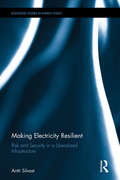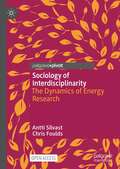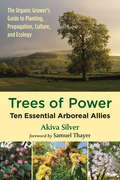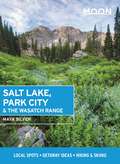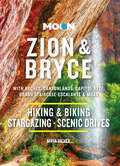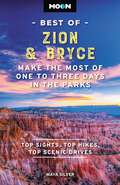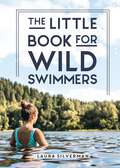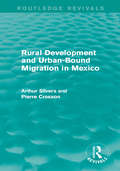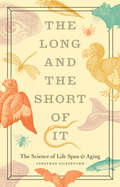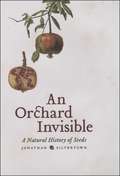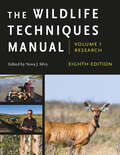- Table View
- List View
Making Electricity Resilient: Risk and Security in a Liberalized Infrastructure (Routledge Studies in Energy Policy)
by Antti SilvastEnergy risk and security have become topical matters in Western and international policy discussions; ranging from international climate change mitigation to investment in energy infrastructures to support economic growth and more sustainable energy provisions. As such, ensuring the resilience of more sustainable energy infrastructures against disruptions has become a growing concern for high-level policy makers. Drawing on interviews, participant observation, policy analysis, and survey research, this book unpacks the work of the authorities, electricity companies, and lay persons that keeps energy systems from failing and helps them to recover from disruptions if they occur. The book explores a number of important issues: the historical security policy of energy infrastructures; control rooms where electricity is traded and maintained in real time; and electricity consumers in their homes. Presenting case studies from Finland and Scandinavia, with comparisons to the United States, the United Kingdom, and the European Union at large, Making Electricity Resilient offers a detailed and innovative analysis of long-term priorities and short-term dynamics in energy risk and resilience. This book will be of great interest to students and scholars of energy policy and security, and science and technology studies.
Sociology of Interdisciplinarity: The Dynamics of Energy Research
by Antti Silvast Chris FouldsThis Open Access book builds upon Science and Technology Studies (STS) and provides a detailed examination of how large-scale energy research projects have been conceived, and with what consequences for those involved in interdisciplinary research, which has been advocated as the zenith of research practice for many years, quite often in direct response to questions that cannot be answered (or even preliminarily investigated) by disciplines working separately. It produces fresh insights into the lived experiences and actual contents of interdisciplinarity, rather than simply commentating on how it is being explicitly advocated. We present empirical studies on large-scale energy research projects from the United Kingdom, Norway, and Finland. The book presents a new framework, the Sociology of Interdisciplinarity, which unpacks interdisciplinary research in practice. This book will be of interest to all those interested in well-functioning interdisciplinary research systems and the dynamics of doing interdisciplinarity, including real ground-level experiences and institutional interdependencies.
Trees of Power: Ten Essential Arboreal Allies
by Akiva SilverThe organic grower's guide to planting, propagation, culture, and ecology Trees are our allies in healing the world. Partnering with trees allows us to build soil, enhance biodiversity, increase wildlife populations, grow food and medicine, and pull carbon out of the atmosphere, sequestering it in the soil. Trees of Power explains how we can work with these arboreal allies, specifically focusing on propagation, planting, and individual species. Author Akiva Silver is an enthusiastic tree grower with years of experience running his own commercial nursery. In this book he clearly explains the most important concepts necessary for success with perennial woody plants. It’s broken down into two parts: the first covering concepts and horticultural skills and the second with in-depth information on individual species. You’ll learn different ways to propagate trees: by seed, grafting, layering, or with cuttings. These time-honored techniques make it easy for anyone to increase their stock of trees, simply and inexpensively. Ten chapters focus on the specific ecology, culture, and uses of different trees, ones that are common to North America and in other temperate parts of the world: Chestnut: The Bread Tree Apples: The Magnetic Center Poplar: The Homemaker Ash: Maker of Wood Mulberry: The Giving Tree Elderberry: The Caretaker Hickory: Pillars of Life Hazelnut: The Provider Black Locust: The Restoration Tree Beech: The Root Runner Trees of Power fills an urgent need for up-to-date information on some of our most important tree species, those that have multiple benefits for humans, animals, and nature. It also provides inspiration for new generations of tree stewards and caretakers who will not only benefit themselves, but leave a lasting legacy for future generations. Trees of Power is for everyone who wants to connect with trees. It is for the survivalist, the gardener, the homesteader, the forager, the permaculturist, the environmentalist, the parent, the schoolteacher, the farmer, and anyone who feels a deep kinship with these magnificent beings.
Moon Salt Lake, Park City & the Wasatch Range: Local Spots, Getaway Ideas, Hiking & Skiing (Travel Guide)
by Maya SilverDiscover brooding mountains, dense forests, and the "greatest snow on earth," just beyond the city limits. Inside Moon Salt Lake, Park City & the Wasatch Range you'll find:Flexible itineraries, from weekends in Salt Lake or Park City to day trips to nearby ski resorts and state parksStrategic advice for outdoors lovers, families, craft beer enthusiasts, festival-goers, and moreOutdoor adventures: Ski the legendary powder at one of Cottonwood Canyons' four resorts, kayak the otherworldly Great Salt Lake, and venture into the vast Uinta Mountains and picnic by a high alpine lake. Climb to the top of Mount Timpanogos for sweeping views, test your nerve on a steep rock-climbing route in Little Cottonwood Canyon, or marvel at the fall color in Wasatch Mountain State ParkMust-see highlights and unique experiences: Immerse yourself the Wild West-meets-Hollywood vibe of Sundance, uncover Mormon history at Temple Square, stroll Ogden's historic main street, and kick back with a craft beer at one of Utah's many emerging breweriesHonest advice from Park City local Maya Silver on when to go, where to eat, and where to stayFull-color photos and detailed maps throughoutFocused coverage of Salt Lake City, Park City, Big and Little Cottonwood Canyons, Ogden, the Great Salt Lake Desert, the Wasatch Back, Oakley, Kamas, and the UintasThorough background on the culture, weather, wildlife, and historyFind your adventure with Moon Salt Lake, Park City & the Wasatch Range.Looking for coverage of the whole state? Try Moon Utah. Exploring nearby? Pick up Moon Zion & Bryce.
Moon Zion & Bryce: Hiking & Biking, Stargazing, Scenic Drives (Moon National Parks Travel Guide)
by Maya SilverSpark your sense of wonder and immerse yourself in the awe-inspiring landscape of Utah's five national parks. Inside Moon Zion & Bryce you'll find:Flexible Itineraries: Unique and adventure-packed ideas ranging from one day in each park to a week-long road trip covering all of them, designed for outdoor adventurers, road-trippers, families, and more The Best Hikes in Utah's National Parks: Individual trail maps, mileage and elevation gains, and backpacking options for Zion, Bryce Canyon, Canyonlands, Arches, Capitol Reef, and Grand Staircase-Escalante Experience the Outdoors: Trek between the thousand-foot walls of the Narrows, hike Angels Landing to unbelievable canyon views, and marvel at hoodoos in Bryce. Soak up the serenity of winter on cross-country skis or take a week-long road trip to hit every park on your list. Contemplate ancient Indigenous rock art throughout the parks, mountain-bike through the desert in Moab, and stay late to spot constellations in the dark sky How to Get There: Up-to-date information on gateway towns like Moab, park entrances, park fees, and tours Where to Stay: Campgrounds, resorts, and more both inside and outside the parks Planning Tips: When to go, what to pack, safety information, and how to avoid the crowds, with full-color photos and easy-to-use maps throughout Expertise and Know-How: Utah-based outdoorswoman Maya Silver shares her tips for travelers who want to backpack, mountain bike, raft, rock climb, hike, and more Find your adventure in Zion and Bryce with Moon. Visiting more of North America's incredible national parks? Try Moon USA National Parks, Moon Yellowstone & Grand Teton, or Moon Best of Grand Canyon. Hitting the road? Try Moon Southwest Road Trip. About Moon Travel Guides: Moon was founded in 1973 to empower independent, active, and conscious travel. We prioritize local businesses, outdoor recreation, and traveling strategically and sustainably. Moon Travel Guides are written by local, expert authors with great stories to tell—and they can't wait to share their favorite places with you. For more inspiration, follow @moonguides on social media.
Moon Best of Zion & Bryce: Make the Most of One to Three Days in the Parks (Moon Best of Travel Guide)
by Maya Silver Moon Travel GuidesWhether you're stopping for a day hike or spending a long weekend under the stars, escape to the great outdoors with Moon Best of Zion & Bryce. Inside you'll find:Easy itineraries for one to three days in Zion and Bryce Canyon National Parks, from a morning hike to Weeping Rock, to a day of river rafting, to a weekend exploring both parks with mix-and-match itinerariesThe top hikes in Zion & Bryce: Whether you're looking to stretch your legs for a couple hours or challenge yourself to an epic trek, you'll find trailheads, detailed trail descriptions, individual maps, mileage, and elevation gains Can't-miss experiences: Make it the perfect getaway for you with the best views, picnic spots, and more. Snap a pic on a sunrise hike or get your adrenaline pumping on a white-water rafting excursion down the Colorado River. Explore the beautiful remains of ancient Native American rock art throughout the parks and learn about the Indigenous culture of the area Stunning full-color photos and maps throughout, plus a full-color foldout mapEssential planning tips: Find out when to go, where to stay, and what to pack, plus up-to-date information on entrance fees, reservations, and safety advice Know-how from Zion and Bryce expert Maya SilverMake the most of your adventure with Moon Best of Zion & Bryce. Spending more time in the parks? Check out Moon Zion & Bryce.About Moon Travel Guides: Moon was founded in 1973 to empower independent, active, and conscious travel. We prioritize local businesses, outdoor recreation, and traveling strategically and sustainably. Moon Travel Guides are written by local, expert authors with great stories to tell—and they can't wait to share their favorite places with you.
The Little Book for Wild Swimmers: Reconnect With Your Wild Side and Discover the Healing Power of Swimming Outdoors
by Laura SilvermanEscape the frantic pace of everyday, reconnect with your wild side and discover the healing power of swimming outdoors. Whether you've already taken the plunge or simply want to dip a toe in, this beautiful book is brimming with all the tips and inspiration you need to find your way back to nature and harness the benefits of wild swimming.
Rural Development and Urban-Bound Migration in Mexico (Routledge Revivals)
by Arthur Silvers Pierre CrossonRapid growth of urban populations is a major characteristic of economic development and demographic change in developing countries leading to industrialisation and modernisation of major cities. Originally published in 1980, this study focusses on these issues using Mexico as a case study as well as analysing the risk of over-urbanisation and what the effects will be on cities such as Mexico City. This title will be of interest to students of Environmental studies and Economics.
Rural Development and Urban-Bound Migration in Mexico (Routledge Revivals)
by Arthur Silvers Pierre CrossonRapid growth of urban populations is a major characteristic of economic development and demographic change in developing countries leading to industrialisation and modernisation of major cities. Originally published in 1980, this study focusses on these issues using Mexico as a case study as well as analysing the risk of over-urbanisation and what the effects will be on cities such as Mexico City. This title will be of interest to students of Environmental studies and Economics.
Demons in Eden: The Paradox of Plant Diversity
by Jonathan SilvertownAt the heart of evolution lies a bewildering paradox. Natural selection favors above all the individual that leaves the most offspring—a superorganism of sorts that Jonathan Silvertown here calls the "Darwinian demon." But if such a demon existed, this highly successful organism would populate the entire world with its own kind, beating out other species and eventually extinguishing biodiversity as we know it. Why then, if evolution favors this demon, is the world filled with so many different life forms? What keeps this Darwinian demon in check? If humankind is now the greatest threat to biodiversity on the planet, have we become the Darwinian demon? Demons in Eden considers these questions using the latest scientific discoveries from the plant world. Readers join Silvertown as he explores the astonishing diversity of plant life in regions as spectacular as the verdant climes of Japan, the lush grounds of the Royal Botanical Gardens at Kew, the shallow wetlands and teeming freshwaters of Florida, the tropical rainforests of southeast Mexico, and the Canary Islands archipelago, whose evolutionary novelties—and exotic plant life—have earned it the sobriquet "the Galapagos of botany." Along the way, Silvertown looks closely at the evolution of plant diversity in these locales and explains why such variety persists in light of ecological patterns and evolutionary processes. In novel and useful ways, he also investigates the current state of plant diversity on the planet to show the ever-challenging threats posed by invasive species and humans. Bringing the secret life of plants into more colorful and vivid focus than ever before, Demons in Eden is an empathic and impassioned exploration of modern plant ecology that unlocks evolutionary mysteries of the natural world.
Demons in Eden: The Paradox of Plant Diversity
by Jonathan SilvertownAt the heart of evolution lies a bewildering paradox. Natural selection favors above all the individual that leaves the most offspring—a superorganism of sorts that Jonathan Silvertown here calls the "Darwinian demon." But if such a demon existed, this highly successful organism would populate the entire world with its own kind, beating out other species and eventually extinguishing biodiversity as we know it. Why then, if evolution favors this demon, is the world filled with so many different life forms? What keeps this Darwinian demon in check? If humankind is now the greatest threat to biodiversity on the planet, have we become the Darwinian demon? Demons in Eden considers these questions using the latest scientific discoveries from the plant world. Readers join Silvertown as he explores the astonishing diversity of plant life in regions as spectacular as the verdant climes of Japan, the lush grounds of the Royal Botanical Gardens at Kew, the shallow wetlands and teeming freshwaters of Florida, the tropical rainforests of southeast Mexico, and the Canary Islands archipelago, whose evolutionary novelties—and exotic plant life—have earned it the sobriquet "the Galapagos of botany." Along the way, Silvertown looks closely at the evolution of plant diversity in these locales and explains why such variety persists in light of ecological patterns and evolutionary processes. In novel and useful ways, he also investigates the current state of plant diversity on the planet to show the ever-challenging threats posed by invasive species and humans. Bringing the secret life of plants into more colorful and vivid focus than ever before, Demons in Eden is an empathic and impassioned exploration of modern plant ecology that unlocks evolutionary mysteries of the natural world.
Demons in Eden: The Paradox of Plant Diversity
by Jonathan SilvertownAt the heart of evolution lies a bewildering paradox. Natural selection favors above all the individual that leaves the most offspring—a superorganism of sorts that Jonathan Silvertown here calls the "Darwinian demon." But if such a demon existed, this highly successful organism would populate the entire world with its own kind, beating out other species and eventually extinguishing biodiversity as we know it. Why then, if evolution favors this demon, is the world filled with so many different life forms? What keeps this Darwinian demon in check? If humankind is now the greatest threat to biodiversity on the planet, have we become the Darwinian demon? Demons in Eden considers these questions using the latest scientific discoveries from the plant world. Readers join Silvertown as he explores the astonishing diversity of plant life in regions as spectacular as the verdant climes of Japan, the lush grounds of the Royal Botanical Gardens at Kew, the shallow wetlands and teeming freshwaters of Florida, the tropical rainforests of southeast Mexico, and the Canary Islands archipelago, whose evolutionary novelties—and exotic plant life—have earned it the sobriquet "the Galapagos of botany." Along the way, Silvertown looks closely at the evolution of plant diversity in these locales and explains why such variety persists in light of ecological patterns and evolutionary processes. In novel and useful ways, he also investigates the current state of plant diversity on the planet to show the ever-challenging threats posed by invasive species and humans. Bringing the secret life of plants into more colorful and vivid focus than ever before, Demons in Eden is an empathic and impassioned exploration of modern plant ecology that unlocks evolutionary mysteries of the natural world.
The Long and the Short of It: The Science of Life Span and Aging
by Jonathan SilvertownEverything that lives will die. That’s the fundamental fact of life. But not everyone dies at the same age: people vary wildly in their patterns of aging and their life spans—and that variation is nothing compared to what’s found in other animal and plant species. A giant fungus found in Michigan has been alive since the Ice Age, while a dragonfly lives but four months, a mayfly half an hour. What accounts for these variations—and what can we learn from them that might help us understand, or better manage, our own aging? With The Long and the Short of It, biologist and writer Jonathan Silvertown offers readers a witty and fascinating tour through the scientific study of longevity and aging. Dividing his daunting subject by theme—death, life span, aging, heredity, evolution, and more—Silvertown draws on the latest scientific developments to paint a picture of what we know about how life span, senescence, and death vary within and across species. At every turn, he addresses fascinating questions that have far-reaching implications: What causes aging, and what determines the length of an individual life? What changes have caused the average human life span to increase so dramatically—fifteen minutes per hour—in the past two centuries? If evolution favors those who leave the most descendants, why haven’t we evolved to be immortal? The answers to these puzzles and more emerge from close examination of the whole natural history of life span and aging, from fruit flies, nematodes, redwoods, and much more. The Long and the Short of It pairs a perpetually fascinating topic with a wholly engaging writer, and the result is a supremely accessible book that will reward curious readers of all ages.
The Long and the Short of It: The Science of Life Span and Aging
by Jonathan SilvertownEverything that lives will die. That’s the fundamental fact of life. But not everyone dies at the same age: people vary wildly in their patterns of aging and their life spans—and that variation is nothing compared to what’s found in other animal and plant species. A giant fungus found in Michigan has been alive since the Ice Age, while a dragonfly lives but four months, a mayfly half an hour. What accounts for these variations—and what can we learn from them that might help us understand, or better manage, our own aging? With The Long and the Short of It, biologist and writer Jonathan Silvertown offers readers a witty and fascinating tour through the scientific study of longevity and aging. Dividing his daunting subject by theme—death, life span, aging, heredity, evolution, and more—Silvertown draws on the latest scientific developments to paint a picture of what we know about how life span, senescence, and death vary within and across species. At every turn, he addresses fascinating questions that have far-reaching implications: What causes aging, and what determines the length of an individual life? What changes have caused the average human life span to increase so dramatically—fifteen minutes per hour—in the past two centuries? If evolution favors those who leave the most descendants, why haven’t we evolved to be immortal? The answers to these puzzles and more emerge from close examination of the whole natural history of life span and aging, from fruit flies, nematodes, redwoods, and much more. The Long and the Short of It pairs a perpetually fascinating topic with a wholly engaging writer, and the result is a supremely accessible book that will reward curious readers of all ages.
The Long and the Short of It: The Science of Life Span and Aging
by Jonathan SilvertownEverything that lives will die. That’s the fundamental fact of life. But not everyone dies at the same age: people vary wildly in their patterns of aging and their life spans—and that variation is nothing compared to what’s found in other animal and plant species. A giant fungus found in Michigan has been alive since the Ice Age, while a dragonfly lives but four months, a mayfly half an hour. What accounts for these variations—and what can we learn from them that might help us understand, or better manage, our own aging? With The Long and the Short of It, biologist and writer Jonathan Silvertown offers readers a witty and fascinating tour through the scientific study of longevity and aging. Dividing his daunting subject by theme—death, life span, aging, heredity, evolution, and more—Silvertown draws on the latest scientific developments to paint a picture of what we know about how life span, senescence, and death vary within and across species. At every turn, he addresses fascinating questions that have far-reaching implications: What causes aging, and what determines the length of an individual life? What changes have caused the average human life span to increase so dramatically—fifteen minutes per hour—in the past two centuries? If evolution favors those who leave the most descendants, why haven’t we evolved to be immortal? The answers to these puzzles and more emerge from close examination of the whole natural history of life span and aging, from fruit flies, nematodes, redwoods, and much more. The Long and the Short of It pairs a perpetually fascinating topic with a wholly engaging writer, and the result is a supremely accessible book that will reward curious readers of all ages.
The Long and the Short of It: The Science of Life Span and Aging
by Jonathan SilvertownEverything that lives will die. That’s the fundamental fact of life. But not everyone dies at the same age: people vary wildly in their patterns of aging and their life spans—and that variation is nothing compared to what’s found in other animal and plant species. A giant fungus found in Michigan has been alive since the Ice Age, while a dragonfly lives but four months, a mayfly half an hour. What accounts for these variations—and what can we learn from them that might help us understand, or better manage, our own aging? With The Long and the Short of It, biologist and writer Jonathan Silvertown offers readers a witty and fascinating tour through the scientific study of longevity and aging. Dividing his daunting subject by theme—death, life span, aging, heredity, evolution, and more—Silvertown draws on the latest scientific developments to paint a picture of what we know about how life span, senescence, and death vary within and across species. At every turn, he addresses fascinating questions that have far-reaching implications: What causes aging, and what determines the length of an individual life? What changes have caused the average human life span to increase so dramatically—fifteen minutes per hour—in the past two centuries? If evolution favors those who leave the most descendants, why haven’t we evolved to be immortal? The answers to these puzzles and more emerge from close examination of the whole natural history of life span and aging, from fruit flies, nematodes, redwoods, and much more. The Long and the Short of It pairs a perpetually fascinating topic with a wholly engaging writer, and the result is a supremely accessible book that will reward curious readers of all ages.
The Long and the Short of It: The Science of Life Span and Aging
by Jonathan SilvertownEverything that lives will die. That’s the fundamental fact of life. But not everyone dies at the same age: people vary wildly in their patterns of aging and their life spans—and that variation is nothing compared to what’s found in other animal and plant species. A giant fungus found in Michigan has been alive since the Ice Age, while a dragonfly lives but four months, a mayfly half an hour. What accounts for these variations—and what can we learn from them that might help us understand, or better manage, our own aging? With The Long and the Short of It, biologist and writer Jonathan Silvertown offers readers a witty and fascinating tour through the scientific study of longevity and aging. Dividing his daunting subject by theme—death, life span, aging, heredity, evolution, and more—Silvertown draws on the latest scientific developments to paint a picture of what we know about how life span, senescence, and death vary within and across species. At every turn, he addresses fascinating questions that have far-reaching implications: What causes aging, and what determines the length of an individual life? What changes have caused the average human life span to increase so dramatically—fifteen minutes per hour—in the past two centuries? If evolution favors those who leave the most descendants, why haven’t we evolved to be immortal? The answers to these puzzles and more emerge from close examination of the whole natural history of life span and aging, from fruit flies, nematodes, redwoods, and much more. The Long and the Short of It pairs a perpetually fascinating topic with a wholly engaging writer, and the result is a supremely accessible book that will reward curious readers of all ages.
The Long and the Short of It: The Science of Life Span and Aging
by Jonathan SilvertownEverything that lives will die. That’s the fundamental fact of life. But not everyone dies at the same age: people vary wildly in their patterns of aging and their life spans—and that variation is nothing compared to what’s found in other animal and plant species. A giant fungus found in Michigan has been alive since the Ice Age, while a dragonfly lives but four months, a mayfly half an hour. What accounts for these variations—and what can we learn from them that might help us understand, or better manage, our own aging? With The Long and the Short of It, biologist and writer Jonathan Silvertown offers readers a witty and fascinating tour through the scientific study of longevity and aging. Dividing his daunting subject by theme—death, life span, aging, heredity, evolution, and more—Silvertown draws on the latest scientific developments to paint a picture of what we know about how life span, senescence, and death vary within and across species. At every turn, he addresses fascinating questions that have far-reaching implications: What causes aging, and what determines the length of an individual life? What changes have caused the average human life span to increase so dramatically—fifteen minutes per hour—in the past two centuries? If evolution favors those who leave the most descendants, why haven’t we evolved to be immortal? The answers to these puzzles and more emerge from close examination of the whole natural history of life span and aging, from fruit flies, nematodes, redwoods, and much more. The Long and the Short of It pairs a perpetually fascinating topic with a wholly engaging writer, and the result is a supremely accessible book that will reward curious readers of all ages.
An Orchard Invisible: A Natural History of Seeds
by Jonathan SilvertownThe story of seeds, in a nutshell, is a tale of evolution. From the tiny sesame that we sprinkle on our bagels to the forty-five-pound double coconut borne by the coco de mer tree, seeds are a perpetual reminder of the complexity and diversity of life on earth. With An Orchard Invisible, Jonathan Silvertown presents the oft-ignored seed with the natural history it deserves, one nearly as varied and surprising as the earth’s flora itself. Beginning with the evolution of the first seed plant from fernlike ancestors more than 360 million years ago, Silvertown carries his tale through epochs and around the globe. In a clear and engaging style, he delves into the science of seeds: How and why do some lie dormant for years on end? How did seeds evolve? The wide variety of uses that humans have developed for seeds of all sorts also receives a fascinating look, studded with examples, including foods, oils, perfumes, and pharmaceuticals. An able guide with an eye for the unusual, Silvertown is happy to take readers on unexpected—but always interesting—tangents, from Lyme disease to human color vision to the Salem witch trials. But he never lets us forget that the driving force behind the story of seeds—its theme, even—is evolution, with its irrepressible habit of stumbling upon new solutions to the challenges of life. "I have great faith in a seed," Thoreau wrote. "Convince me that you have a seed there, and I am prepared to expect wonders." Written with a scientist’s knowledge and a gardener’s delight, An Orchard Invisible offers those wonders in a package that will be irresistible to science buffs and green thumbs alike.
An Orchard Invisible: A Natural History of Seeds
by Jonathan SilvertownThe story of seeds, in a nutshell, is a tale of evolution. From the tiny sesame that we sprinkle on our bagels to the forty-five-pound double coconut borne by the coco de mer tree, seeds are a perpetual reminder of the complexity and diversity of life on earth. With An Orchard Invisible, Jonathan Silvertown presents the oft-ignored seed with the natural history it deserves, one nearly as varied and surprising as the earth’s flora itself. Beginning with the evolution of the first seed plant from fernlike ancestors more than 360 million years ago, Silvertown carries his tale through epochs and around the globe. In a clear and engaging style, he delves into the science of seeds: How and why do some lie dormant for years on end? How did seeds evolve? The wide variety of uses that humans have developed for seeds of all sorts also receives a fascinating look, studded with examples, including foods, oils, perfumes, and pharmaceuticals. An able guide with an eye for the unusual, Silvertown is happy to take readers on unexpected—but always interesting—tangents, from Lyme disease to human color vision to the Salem witch trials. But he never lets us forget that the driving force behind the story of seeds—its theme, even—is evolution, with its irrepressible habit of stumbling upon new solutions to the challenges of life. "I have great faith in a seed," Thoreau wrote. "Convince me that you have a seed there, and I am prepared to expect wonders." Written with a scientist’s knowledge and a gardener’s delight, An Orchard Invisible offers those wonders in a package that will be irresistible to science buffs and green thumbs alike.
An Orchard Invisible: A Natural History of Seeds
by Jonathan SilvertownThe story of seeds, in a nutshell, is a tale of evolution. From the tiny sesame that we sprinkle on our bagels to the forty-five-pound double coconut borne by the coco de mer tree, seeds are a perpetual reminder of the complexity and diversity of life on earth. With An Orchard Invisible, Jonathan Silvertown presents the oft-ignored seed with the natural history it deserves, one nearly as varied and surprising as the earth’s flora itself. Beginning with the evolution of the first seed plant from fernlike ancestors more than 360 million years ago, Silvertown carries his tale through epochs and around the globe. In a clear and engaging style, he delves into the science of seeds: How and why do some lie dormant for years on end? How did seeds evolve? The wide variety of uses that humans have developed for seeds of all sorts also receives a fascinating look, studded with examples, including foods, oils, perfumes, and pharmaceuticals. An able guide with an eye for the unusual, Silvertown is happy to take readers on unexpected—but always interesting—tangents, from Lyme disease to human color vision to the Salem witch trials. But he never lets us forget that the driving force behind the story of seeds—its theme, even—is evolution, with its irrepressible habit of stumbling upon new solutions to the challenges of life. "I have great faith in a seed," Thoreau wrote. "Convince me that you have a seed there, and I am prepared to expect wonders." Written with a scientist’s knowledge and a gardener’s delight, An Orchard Invisible offers those wonders in a package that will be irresistible to science buffs and green thumbs alike.
An Orchard Invisible: A Natural History of Seeds
by Jonathan SilvertownThe story of seeds, in a nutshell, is a tale of evolution. From the tiny sesame that we sprinkle on our bagels to the forty-five-pound double coconut borne by the coco de mer tree, seeds are a perpetual reminder of the complexity and diversity of life on earth. With An Orchard Invisible, Jonathan Silvertown presents the oft-ignored seed with the natural history it deserves, one nearly as varied and surprising as the earth’s flora itself. Beginning with the evolution of the first seed plant from fernlike ancestors more than 360 million years ago, Silvertown carries his tale through epochs and around the globe. In a clear and engaging style, he delves into the science of seeds: How and why do some lie dormant for years on end? How did seeds evolve? The wide variety of uses that humans have developed for seeds of all sorts also receives a fascinating look, studded with examples, including foods, oils, perfumes, and pharmaceuticals. An able guide with an eye for the unusual, Silvertown is happy to take readers on unexpected—but always interesting—tangents, from Lyme disease to human color vision to the Salem witch trials. But he never lets us forget that the driving force behind the story of seeds—its theme, even—is evolution, with its irrepressible habit of stumbling upon new solutions to the challenges of life. "I have great faith in a seed," Thoreau wrote. "Convince me that you have a seed there, and I am prepared to expect wonders." Written with a scientist’s knowledge and a gardener’s delight, An Orchard Invisible offers those wonders in a package that will be irresistible to science buffs and green thumbs alike.
Sandy Beaches as Endangered Ecosystems: Environmental Problems, Possible Assessment and Management Solutions
by Sílvia C. Gonçalves and Susana M.F. FerreiraSandy beaches are the most abundant coastal environments worldwide, which have an undeniable and unique ecological value. Presently, they are amongst the most endangered ecosystems in the biosphere, mainly due to the influence of several human activities. In this book, renowned scientists from around the world describe key attributes of sandy beaches and highlight the problems which impact them. Specific tools encompassing the physical environment and the biota are pointed out, at different levels of ecological organization. The book also covers suitable management, conservation programmes and respective actions, where ecologic, economic and social dimensions are comprehensively integrated.
The Wildlife Techniques Manual: Volume 1: Research. Volume 2: Management
by Nova J. SilvySince its original publication in 1960, The Wildlife Techniques Manual has remained the cornerstone text for the professional wildlife biologist. Now fully revised and updated, this eighth edition promises to be the most comprehensive resource on wildlife biology, conservation, and management for years to come. Superbly edited by Nova J. Silvy and published in association with The Wildlife Society, the 50 authoritative chapters included in this work provide a full synthesis of methods used in the field and laboratory. Chapter authors, all leading wildlife professionals, explain and critique traditional and new methodologies and offer thorough discussions of a wide range of relevant topics. To effectively incorporate the explosion of new information in the wildlife profession, this latest edition is logically organized into a 2-volume set: Volume 1 is devoted to research techniques and Volume 2 focuses on pragmatic management methodologies. Volume 1 describes research design and proper analytic methods prior to conducting research, as well as methods and considerations for capturing and handling wild animals and information on identification and marking of captured animals. It also includes new chapters on nutritional research and field sign identification, and on emerging topics, including structured decision-making. Finally, Volume 1 addresses measurements of wildlife abundance and habitat and research on individual animals. Volume 2 begins with a section on the relationship between research and management including public outreach, described in a context that encourages engagement prior to initiation of management. An adaptive management approach is described as a cornerstone of natural resource management, followed by a section on managing landscapes and wildlife populations. The volume also includes new chapters on ethics in wildlife science and conservation, conflict resolution and management, and land reclamation. A standard text in a variety of courses, the Techniques Manual, as it is commonly called, covers every aspect of modern wildlife management and provides practical information for applying the hundreds of methods described in its pages. This deft and thorough update ensures that The Wildlife Techniques Manual will remain an indispensable resource, one that professionals and students in wildlife biology, conservation, and management simply cannot do without.
Finding the Mother Tree: Uncovering the Wisdom and Intelligence of the Forest
by Suzanne Simard'A scientific memoir as gripping as any HBO drama series' Kate Kellaway, ObserverA dazzling scientific detective story from the ecologist who first discovered the hidden language of trees No one has done more to transform our understanding of trees than the world-renowned scientist Suzanne Simard. Now she shares the secrets of a lifetime spent uncovering startling truths about trees: their cooperation, healing capacity, memory, wisdom and sentience. Raised in the forests of British Columbia, where her family has lived for generations, Professor Simard did not set out to be a scientist. She was working in the forest service when she first discovered how trees communicate underground through an immense web of fungi, at the centre of which lie the Mother Trees: the mysterious, powerful entities that nurture their kin and sustain the forest. Though her ground-breaking findings were initially dismissed and even ridiculed, they are now firmly supported by the data. As her remarkable journey shows us, science is not a realm apart from ordinary life, but deeply connected with our humanity. In Finding the Mother Tree, she reveals how the complex cycle of forest life - on which we rely for our existence - offers profound lessons about resilience and kinship, and must be preserved before it's too late.
